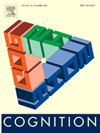Implicit prediction as a consequence of statistical learning
IF 2.8
1区 心理学
Q1 PSYCHOLOGY, EXPERIMENTAL
引用次数: 0
Abstract
The sensory input that we encounter while navigating through each day is highly structured, containing patterns that repeat over time. Statistical learning is the process of becoming attuned to these patterns and can facilitate online processing. These online facilitation effects are often ascribed to prediction, in which information about an upcoming event is represented before it occurs. However, previously observed facilitation effects could also be due to retrospective processing. Here, using a speech-based segmentation paradigm, we tested whether statistical learning leads to the prediction of upcoming syllables. Specifically, we probed for a behavioural hallmark of genuine prediction, in which a given prediction benefits online processing when confirmed, but incurs costs if disconfirmed. In line with the idea that prediction is a key outcome of statistical learning, we found a trade-off in which a greater benefit for processing predictable syllables was associated with a greater cost in processing syllables that occurred in a “mismatch” context, outside of their expected positions. This trade-off in making predictions was evident at both the participant and the item (i.e., individual syllable) level. Further, we found that prediction did not emerge indiscriminately to all syllables in the input stream, but was deployed selectively according to the trial-by-trial demands of the task. Explicit knowledge of a given word was not required for prediction to occur, suggesting that prediction operates largely implicitly. Overall, these results provide novel behavioural evidence that prediction arises as a natural consequence of statistical learning.
作为统计学习结果的内隐预测
我们每天在导航中遇到的感官输入是高度结构化的,包含随着时间重复的模式。统计学习是适应这些模式的过程,可以促进在线处理。这些在线促进效应通常归因于预测,在预测中,关于即将发生的事件的信息在事件发生之前就被表示出来了。然而,先前观察到的促进效应也可能是由于回顾性加工。在这里,我们使用基于语音的分割范例,测试了统计学习是否会导致对即将到来的音节的预测。具体来说,我们探索了真实预测的行为特征,其中给定的预测在被证实时有利于在线处理,但如果不被证实则会产生成本。根据预测是统计学习的关键结果这一观点,我们发现了一种权衡,即处理可预测音节的更大收益与处理“不匹配”上下文中出现的音节的更大成本相关,超出了它们的预期位置。这种预测的权衡在参与者和项目(即单个音节)水平上都很明显。此外,我们发现预测并不是不分青红皂白地出现在输入流中的所有音节上,而是根据任务的逐次要求有选择地部署。预测并不需要对给定单词有明确的了解,这表明预测在很大程度上是隐性的。总的来说,这些结果提供了新的行为学证据,表明预测是统计学习的自然结果。
本文章由计算机程序翻译,如有差异,请以英文原文为准。
求助全文
约1分钟内获得全文
求助全文
来源期刊

Cognition
PSYCHOLOGY, EXPERIMENTAL-
CiteScore
6.40
自引率
5.90%
发文量
283
期刊介绍:
Cognition is an international journal that publishes theoretical and experimental papers on the study of the mind. It covers a wide variety of subjects concerning all the different aspects of cognition, ranging from biological and experimental studies to formal analysis. Contributions from the fields of psychology, neuroscience, linguistics, computer science, mathematics, ethology and philosophy are welcome in this journal provided that they have some bearing on the functioning of the mind. In addition, the journal serves as a forum for discussion of social and political aspects of cognitive science.
 求助内容:
求助内容: 应助结果提醒方式:
应助结果提醒方式:


